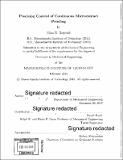| dc.contributor.advisor | David Hardt. | en_US |
| dc.contributor.author | Bageant, Maia R. (Maia Reynolds) | en_US |
| dc.contributor.other | Massachusetts Institute of Technology. Department of Mechanical Engineering. | en_US |
| dc.date.accessioned | 2018-05-23T16:31:50Z | |
| dc.date.available | 2018-05-23T16:31:50Z | |
| dc.date.copyright | 2018 | en_US |
| dc.date.issued | 2018 | en_US |
| dc.identifier.uri | http://hdl.handle.net/1721.1/115721 | |
| dc.description | Thesis: Ph. D., Massachusetts Institute of Technology, Department of Mechanical Engineering, 2018. | en_US |
| dc.description | Cataloged from PDF version of thesis. Due to the condition of the original material, there are unavoidable flaws in this reproduction. Pages 257 to 263 in the original document contain text that runs off the edge of the page. | en_US |
| dc.description | Includes bibliographical references (pages 265-271). | en_US |
| dc.description.abstract | This work focuses on the development of experimental equipment enabling the scale-up of microcontact printing for industrial use. An examination of existing experimental microcontact printing hardware and identification of its deficiencies are given, and the design and implementation of improvements are detailed. In particular, these improvements focus on the enabling of closed-loop force control of the printing process by the establishment of a deterministic computational platform and additional sensing. An understanding and rationale for the overall control design of the microcontact printing process is developed. Though the goal is to control the compression of each individual microscale feature on the microcontact printing stamp, force control is shown to offer significant advantages over displacement control. Analytical dynamic models of the system are developed, iterated, and verified experimentally. Initially, a simple model consisting of two separable single-input, single-output (SISO) systems was developed, but this model was shown to fail to capture relevant dynamics. A twelfth-order multi-input, multi-output (MIMO) model describing the system was then developed and verified experimentally using specially constructed frequency response measurement tools. Controller design was then undertaken for both the simple and complex model. The simple model was accommodated with proportional-integral and pure integral designs. The complex model required an augmented full-state feedback controller with a Kalman state estimator, which was designed and implemented in discrete time. Nonideal properties inherent to the printhead system, including uncontrollability and unobservability, were quickly identified. Maximum potential control performance under these constraints was explored and demonstrated experimentally, and it was shown that the inherent limitations made satisfactory closed-loop performance impossible. A conceptual printhead design for control is also presented. Mechanical design principles based on the lessons indicated by the system model and control design are laid out. A conceptual design is developed based on these principles, and basic geometry, packaging, and component selection is completed, allowing for a dynamic system model to be evaluated. The new printhead design is found to offer a significantly improved dynamic response, making the force control problem very tractable, and additionally solves a number of other design flaws inherent to the original printhead. An example control design and resulting performance is presented. | en_US |
| dc.description.statementofresponsibility | by Maia R. Bageant. | en_US |
| dc.format.extent | 271 pages | en_US |
| dc.language.iso | eng | en_US |
| dc.publisher | Massachusetts Institute of Technology | en_US |
| dc.rights | MIT theses are protected by copyright. They may be viewed, downloaded, or printed from this source but further reproduction or distribution in any format is prohibited without written permission. | en_US |
| dc.rights.uri | http://dspace.mit.edu/handle/1721.1/7582 | en_US |
| dc.subject | Mechanical Engineering. | en_US |
| dc.title | Precision control of continuous microcontact printing | en_US |
| dc.type | Thesis | en_US |
| dc.description.degree | Ph. D. | en_US |
| dc.contributor.department | Massachusetts Institute of Technology. Department of Mechanical Engineering | |
| dc.identifier.oclc | 1036986541 | en_US |
